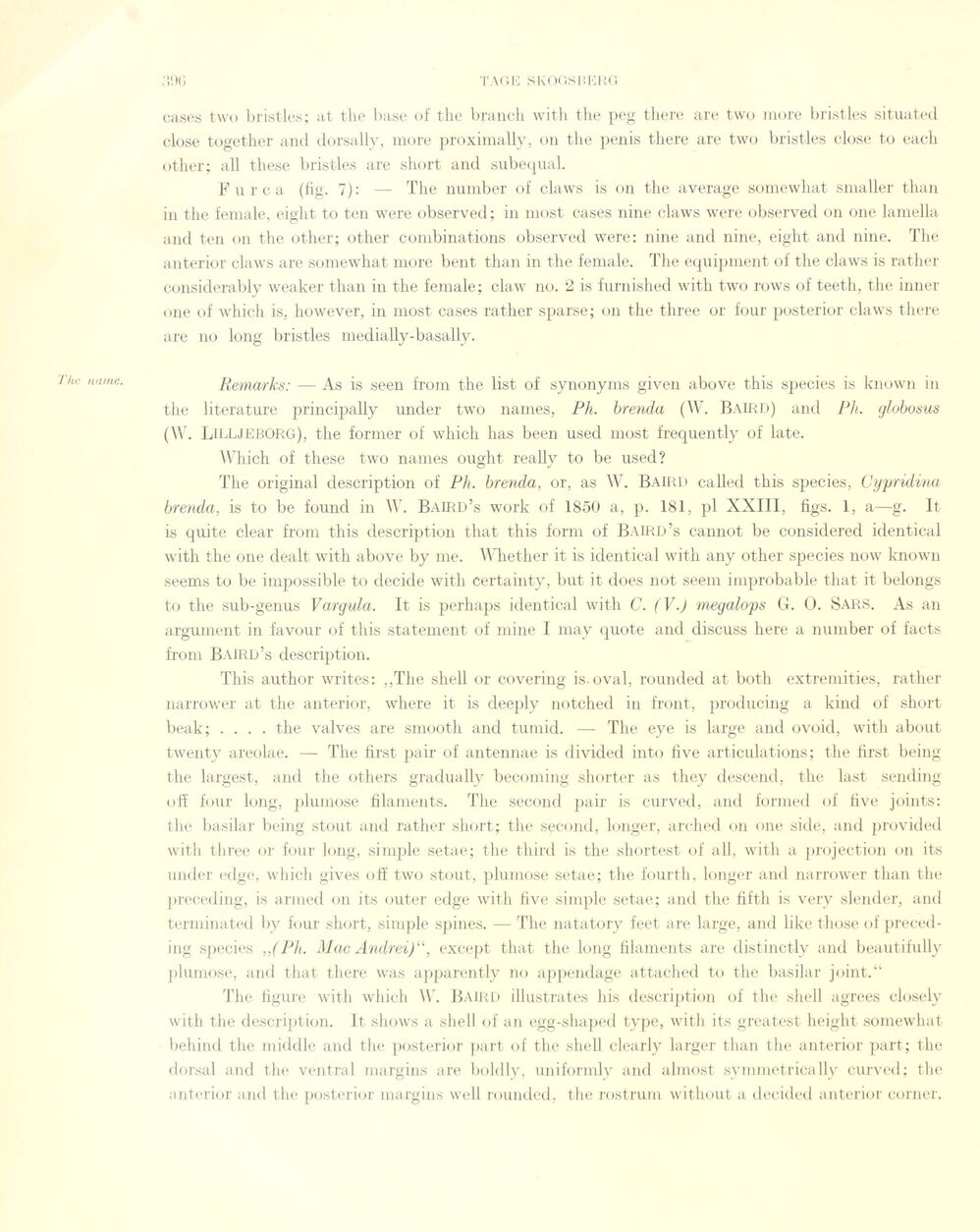
Full resolution (JPEG) - On this page / på denna sida - Sidor ...

<< prev. page << föreg. sida << >> nästa sida >> next page >>
Below is the raw OCR text
from the above scanned image.
Do you see an error? Proofread the page now!
Här nedan syns maskintolkade texten från faksimilbilden ovan.
Ser du något fel? Korrekturläs sidan nu!
This page has never been proofread. / Denna sida har aldrig korrekturlästs.
cases tvvo brist les; at the base of tke brauch with the peg there are two more brist les situated
close together and dorsallv, more proximally, on tbe penis there are two bristles close to eacli
other; all these bristles are short and subequal.
Furca (fig. 7): — The number of claws is on the average somewhat smaller than
in the female, eight to ten were observed; in most cases nine claws were observed on one lamella
and ten on the other; other combinations observed were: nine and nine, eight and nine. The
anterior claws are somewhat more bent than in the female. The equipment of the claws is rather
considerably weaker than in the female; claw no. 2 is furnished with two rows of teeth, the inner
one of which is, however, in most cases rather sparse; on the three or four posterior claws there
are no long bristles medially-basally.
Remarks: — As is seen from the list of synonyms given above this species is known in
the literature principally under two names, Ph. brenda (W. Baird) and Pli. globusus
(W. Lilljeborg), the former of which has been used most frequently of late.
Which of these two names ought really to be used?
The original description of Ph. brenda, or, as W. Baird called this species, Cypridina
brenda, is to be found in W. Baird’s worlc of 1850 a, p. 181, pl XXIII, figs. 1, a—g. It
is quite clear from this description that this form of Baird’s cannot be considered identical
with the one dealt with above by me. Whether it is identical with any other species now known
seems to be impossible to decide with certaint.y, but it does not seem improbable that it belongs
to the sub-genus Vargula. It is perhaps identical with C. ( V.) megalops G. O. Sars. As an
argument in favour of this statement of mine I may quote and discuss here a number of facts
from Baird’s description.
This author writes: ,,The shell or covering is.oval, rounded at both extremities, rather
narrower at the anterior, where it is deeply notched in front, producing a kind of short
beak; .... the valves are smooth and tumid. — The eye is large and ovoid, with about
twenty areolae. —■ The first pair of antennae is divided into five articulations; the first being
the largest, and the others gradually becoming shorter as they descend, the last sending
off four long, plumose filaments. The second pair is curved, and formed of five joints:
the basilar being stout and rather short; the second, longer, arched on one side, and provided
with three or four long, simple setae; the third is the shortest of ail, with a projection on its
under edge, which gives off two stout, plumose setae; the fourth, longer and narrower than the
preceding, is armed on its outer edge with five simple setae; and the fifth is very slender, and
terminated by four short, simple spines. — The natatory feet are large, and like those of
preceding species „(Ph. Mac Andrei)“, except that the long filaments are distinctly and beautifully
plumose, and that there was apparently no appendage attached to the basilar joint.“
The figure with which W. Baird illustrâtes his description of the shell agréés closely
with the description, lt shows a shell of an egg-shaped type, with its greatest height somewhat
behind the middle and the posterior part of the shell clearly larger than the anterior part; the
dorsal and the ventral margins are boldly, uniformly and almost symmetrically curved; the
anterior and the posterior margins well rounded, the rostrum without a décidée! anterior corner.
<< prev. page << föreg. sida << >> nästa sida >> next page >>